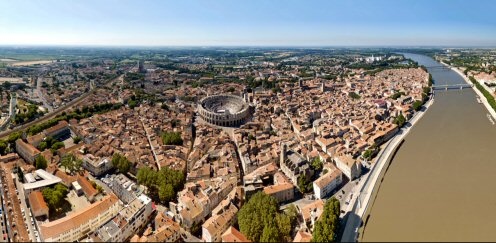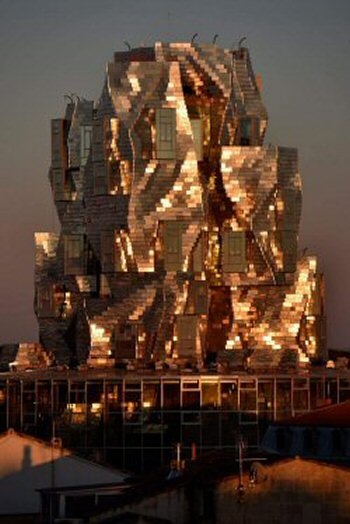Arles is a city in the south of France, in the Bouches-du-Rhône department.
History:
The Ligurians were in this area from about 800 BC. Later, Celtic influences have been discovered. The city became an important Phoenician trading port, before being taken by the Romans.
The Romans took the town in 123 BC and expanded it into an important city, with a canal link to the Mediterranean Sea being constructed in 104 BC. However, it struggled to escape the shadow of Massalia (Marseilles) further along the coast. Its chance came when it sided with Julius Caesar against Pompey, providing military support. Massalia backed Pompey; when Caesar emerged victorious, Massalia was stripped of its possessions, which were transferred to Arelate as a reward. The town was formally established as a colony for veterans of the Roman legion Legio VI Ferrata, which had its base there.
There is plenty to enjoy in the city;
Arles has important Roman remnants, most of which have been listed as UNESCO World Heritage Sites since 1981 within the Arles, Roman and Romanesque Monuments group. They include:
The Gallo-Roman theatre
The arena or amphitheatre
The Alyscamps (Roman necropolis)
The Thermae of Constantine
The cryptoporticus
Franck Gehry Tower
Arles Obelisk
Barbegal aqueduct and mill
The Church of St. Trophime (Saint Trophimus), formerly a cathedral, is a major work of Romanesque architecture, and the representation of the Last Judgment on its portal is considered one of the finest examples of Romanesque sculpture, as are the columns in the adjacent cloister.
The town also has a museum of ancient history, the Musée de l'Arles et de la Provence antiques, with one of the best collections of Roman sarcophagi to be found anywhere outside Rome itself. Other museums include the Musée Réattu and the Museon Arlaten.
The courtyard of the Old Arles hospital, now named "Espace Van Gogh," is a center for Vincent van Gogh's works, several of which are masterpieces. The garden, framed on all four sides by buildings of the complex, is approached through arcades on the first floor. A circulation gallery is located on the first and second floors.
The Arles market - The Arles market is not only one of the most beautiful markets in Provence, but also one of the largest. Each business occupies an average of 5 linear meters, the Saturday market offers more than 2.5 km of display.
On Wednesday it stretches along boulevard Émile-Combes, from Place Lamartine to the crossroads of the cruise.
Saturday on the boulevards of Lices, Georges-Clemenceau and Émile-Combes.
FOR MORE INFORMATION, CLICK HERE - http://www.ville-arles.fr/economie/foire-marche/marche-foire-economie/le-marche-d-arles.php
Arles is just 20 Mins from Les Baux de Provence - Classified resort, one of the Most Beautiful Villages of France, Les Baux-de-Provence affirm their image of prestigious site within the Alpilles Regional Natural Park. The Baux-de-Provence are unique, because a little more magical and a little more illustrious in this extraordinary setting. However, the very essence that makes the charm and the perfume so special of the Provencal villages is there: the small squares, the shaded terraces, the narrow streets and their shops.
For more information, click here - http://www.lesbauxdeprovence.com/fr
A large part of the Camargue is located on the territory of the commune, making it the largest commune in Metropolitan France in terms of territory (though Maripasoula, French Guiana, is much larger).
The Dutch post-Impressionist painter Vincent van Goghlived in Arles from 1888 to 1889 and produced over 300 paintings and drawings during his time there. An international photography festival has been held in the city since 1970.

Arles became renowned as a cultural and religious centre during the late Roman Empire. It was the birthplace of the sceptical philosopher Favorinus. It was also a key location for Roman Christianity and an important base for the Christianization of Gaul. The city's bishopric was held by a series of outstanding clerics, beginning with Saint Trophimus around 225 and continuing with Saint Honoratus, then Saint Hilarius in the first half of the 5th century. The political tension between the Catholic bishops of Arles and the Visigothic kings is epitomized in the career of the Frankish St. Caesarius, bishop of Arles 503–542, who was suspected by the Arian Visigoth Alaric II of conspiring with the Burgundians to turn over the Arelate to Burgundy, and was exiled for a year to Bordeaux in Aquitaine. Political tensions were evident again in 512, when Arles held out against Theodoric the Great and Caesarius was imprisoned and sent to Ravenna to explain his actions before the Ostrogothic king.
The friction between the Arian Christianity of the Visigoths and the Catholicism of the bishops sent out from Rome established deep roots for religious heterodoxy, even heresy, in Occitan culture. At Treves in 385, Priscillian achieved the distinction of becoming the first Christian executed for heresy (Manichaean in his case, see also Cathars,Camisards). Despite this tension and the city's decline in the face of barbarian invasions, Arles remained a great religious centre and host of church councils (see Council of Arles), the rival of Vienne, for hundreds of years.
After the inauguration of the new National School of Photography by the Minister of Culture, more than 17,000 professionals and at least 1,500 journalists from around the world are expected for the opening of the 50th edition of the Rencontres Internationales d'Arles. With this rendezvous that is to photography what Cannes is in the cinema, the former imperial Gallo-Roman colony continues to metamorphose.
Les Rencontres d'Arles offer a programme of eclectic and contemporary art: one week full of events and two months of exhibitions throughout the city. Arles thus stands out both in France and the world over. It was launched in 1969 by photograph and image enthusiasts, Lucien Clergue, Jean-Maurice Rouquette, Michel Tournier and others. Every year this marks a high point for photographers and marks Arles out as an international capital of photography.
Image above: Franck Gehry Tower, the landmark of the new Arles Contemporary Art Center
The opening fortnight
Les Rencontres organise open air night projections at the Roman Theatre, a unique international event. Every evening a photographer or a photography specialist presents photographs sometimes accompanied by a concert or performances, focusing on a different subject every evening.
Conferences and debates are also held during the opening week.
For six years the "La Nuit de l'Année" has projected photographs of various figures working in the media, magazines, or agencies, onto giant screens along a spectacular photographic night walk in the city centre.
The exhibitions
Some 60 exhibitions are set up around emblematic sites of Arlesian heritage, but also in places that are usually closed to the public and which are thus brought back to life during the summer. A few years ago, Les Rencontres were the first to organize an exhibition in old the railway workshops. In 2010 Les Rencontres first organized the "Village des Rencontres" on this site, that stands as a symbol of Arles' cultural future. It is a new space in which to meet photography enthusiasts, collectors and professionals, that come during the opening days of the festival.
Transport:
The Gare d'Arles railway station offers connections to Avignon, Nîmes, Marseille, Paris, Bordeaux and several regional destinations.
Arles does not have its own commercial airport, but is served by a number of airports in the region, most notably the major international airport of Marseille Provence approximately an hour's drive away.
The A54 autoroute toll motorway, which locally connects Salon-de-Provence with Nîmes and in a wider sense forms part of European route E80, passes by Arles.
The Rhône, which for navigation purposes is classified as a Class V waterway as far upstream as Lyon, is an historically important transport route connecting the inland Rhône-Alpes region with the Mediterranean Sea. The port of Arles and its adjacent rail and road connections provides a major transshipment node, which in 2013 handled approximately 450,000 tonnes of goods.
To view one of our spectacular gite complexes currently for sale, click here - https://www.buy-in-france.com/beautiful-accommodation-with-large-pool-between-camargue-and-alpilles-5km-from-arles---provence.html

















